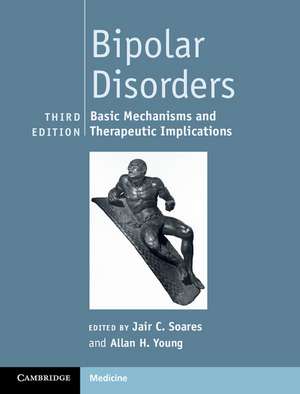Bipolar Disorders: Basic Mechanisms and Therapeutic Implications
Editat de Jair C. Soares, Allan H. Youngen Limba Engleză Hardback – 24 mai 2016
Preț: 729.42 lei
Preț vechi: 767.81 lei
-5% Nou
Puncte Express: 1094
Preț estimativ în valută:
139.58€ • 149.25$ • 116.37£
139.58€ • 149.25$ • 116.37£
Carte indisponibilă temporar
Doresc să fiu notificat când acest titlu va fi disponibil:
Se trimite...
Preluare comenzi: 021 569.72.76
Specificații
ISBN-13: 9781107062719
ISBN-10: 1107062713
Pagini: 312
Ilustrații: 7 b/w illus. 9 colour illus. 23 tables
Dimensiuni: 194 x 254 x 18 mm
Greutate: 0.85 kg
Ediția:3
Editura: Cambridge University Press
Colecția Cambridge University Press
Locul publicării:New York, United States
ISBN-10: 1107062713
Pagini: 312
Ilustrații: 7 b/w illus. 9 colour illus. 23 tables
Dimensiuni: 194 x 254 x 18 mm
Greutate: 0.85 kg
Ediția:3
Editura: Cambridge University Press
Colecția Cambridge University Press
Locul publicării:New York, United States
Cuprins
List of contributors; Preface; 1. The classification of bipolar disorders: implications for clinical research Michael J. Ostacher, Mark A. Frye and Trisha Suppes; 2. Prospects for the development of animal models for the study of bipolar disorder Trevor R. Norman; 3. Abnormalities in catecholamines and the pathophysiology of bipolar disorder Alexander W. Charney, Sehrish Sayed and Dennis S. Charney; 4. Serotonergic dysfunction in bipolar disorder Martin J. Lan and J. John Mann; 5. Involvement of GABAergic/glutamatergic pathways in mood disorders Paul Stokes and James Stone; 6. Oxidative stress and neuronal resilience: implications for the pathophysiology of bipolar disorders Gabriela Delevati Colpo, Gabriel Rodrigo Fries, Laura Stertz and Flávio Kapczinski; 7. Post-mortem studies in bipolar disorder Francine M. Benes and Sivan Subburaju; 8. The neuroendocrinology of stress in the pathophysiology of bipolar disorders Allan H. Young and Alessandro Colasanti; 9. Brain imaging abnormalities in bipolar disorder Marsal Sanches and Jair C. Soares; 10. Sleep and circadian rhythms in bipolar disorders Sara Dallaspezia and Francesco Benedetti; 11. Infectious agents: role in causation of bipolar disorders? Olaoluwa O. Okusaga; 12. EEGs and ERPs in bipolar disorders R. Hamish McAllister-Williams; 13. Genetic factors in the etiology of bipolar disorder Consuelo Walss-Bass; 14. Neurocognitive findings in bipolar disorder David C. Glahn, Carrie E. Bearden and Sophia Frangou; 15. Psychotherapeutic interventions in bipolar disorder Thomas Daniel Meyer; 16. The kindling/sensitization model and the pathophysiology of bipolar disorder Robert M. Post; 17. Biological factors in bipolar disorder in childhood and adolescence Melissa A. Brotman, Banafsheh Sharif-Askary, Daniel P. Dickstein and Ellen Leibenluft; 18. Biological factors in bipolar disorder in late life Brent Forester, Ariel G. Gildengers and Robert C. Young; 19. Perspectives for new pharmacological interventions Charles L. Bowden; 20. Physical health and metabolic dysfunction in bipolar disorder Joshua D. Rosenblat, Danielle S. Cha, Rodrigo B. Mansur and Roger S. McIntyre; 21. Immune dysregulation in bipolar disorder Antonio Lucio Teixeira, Izabela Guimarães Barbosa and Moisés Evandro Bauer; Index.
Descriere
Covers advances in the fields of genetics, neuropsychopharmacology, psychosocial factors, and more, emphasizing therapeutic potential.
